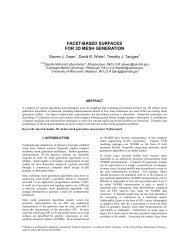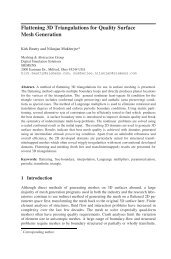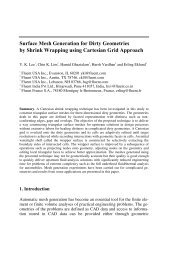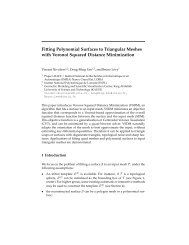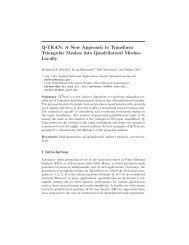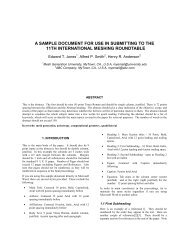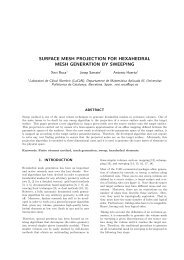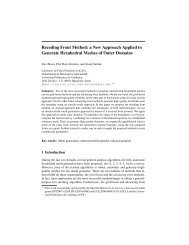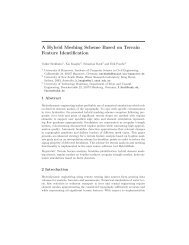12 Suzanne M. Shontz and Dragos M. Nistor<strong>Simplification</strong> Percentage<strong>Simplification</strong> PercentageNaïve Marking Algorithm Inverse Reduction Algorithmiter # vertices # faces %v simp %f simp # vertices # faces %v simp %f simp0 863182 1726364 — — 863182 1726364 — —1 735345 1470688 14.8 14.8 779354 1558590 9.7 9.72 646764 1292036 25.1 25.2 704379 1408640 18.4 18.43 573431 1142601 33.6 33.8 639370 1276589 25.9 26.14 512166 1042650 40.7 39.6 581774 1161369 32.6 32.75 458718 952966 46.9 44.8 531048 1059586 38.5 38.66 412135 872794 52.3 49.4 486874 970716 43.6 43.87 371523 801356 57.0 53.6 446693 889413 48.3 48.58 336120 737405 61.1 57.3 410960 816781 52.4 52.79 305243 680268 64.6 60.6 379788 753007 56.0 56.410 278305 629188 67.8 63.6 351150 693992 59.3 59.8Table 6. The simplification percentage of the gargoyle mesh over multiple iterationsof the <strong>CPU</strong>-<strong>GPU</strong> naïve marking algorithm and the <strong>CPU</strong>-<strong>GPU</strong> inverse reductionalgorithm.too much loss of detail. This rein<strong>for</strong>ces the notion that larger meshes can besimplified more without seeing any visible effects.(a) Armadillo (b) Bunny (c) Gargoyle(d) Hand (e) Horse (f) KittenFig. 6. The resulting meshes after 10 iterations of the <strong>CPU</strong>-<strong>GPU</strong> naïve markingalgorithm.Tables 5 and 6 show the vertex and face simplification percentages as afunction of iteration in each mesh. Note that %v simp and %f simp represent
<strong>CPU</strong>-<strong>GPU</strong> <strong>Algorithms</strong> <strong>for</strong> <strong>Triangular</strong> <strong>Surface</strong> <strong>Mesh</strong> <strong>Simplification</strong> 13the percentages of vertex and face simplification, respectively, in these tables.The amount of simplification per<strong>for</strong>med each iteration decreases. This suggeststhat as the vertex and element counts increase, the decrease in runningtime achieved by using the <strong>GPU</strong> simplification algorithm instead of the <strong>CPU</strong>simplification algorithm increases as well.To examine the effects of splitting the mesh simplification workload betweenthe <strong>CPU</strong> and the <strong>GPU</strong> using the inverse reduction algorithm, werecorded the time spent during the simplification process <strong>for</strong> various <strong>CPU</strong>-<strong>GPU</strong> splits on all test cases. We tested the following <strong>CPU</strong>-<strong>GPU</strong> workloadsplits: 100-0, 95-5, 90-10, . . . , and 0-100. The time taken in seconds <strong>for</strong> the<strong>CPU</strong>-<strong>GPU</strong> splits can be seen in Figure 7. The proportion of running timespent in the <strong>GPU</strong> <strong>for</strong> the tested is shown in Table 7. The <strong>GPU</strong> memory usage<strong>for</strong> the tested splits is shown in Table 3.(a) Bunny(b) GargoyleFig. 7. The time taken to simplify each test case <strong>for</strong> every split using the <strong>CPU</strong>-<strong>GPU</strong>inverse reduction algorithm. As the <strong>CPU</strong>-<strong>GPU</strong> split increases, the <strong>CPU</strong> workloadincreases, and the <strong>GPU</strong> workload decreases.The <strong>CPU</strong>-<strong>GPU</strong> inverse reduction algorithm shows an increase in runningtime on the horse mesh, whereas it shows a decrease in running time onthe armadillo, bunny, gargoyle, hand, and kitten meshes with respect to anincreasing workload on the <strong>GPU</strong>. If the mesh is large, the time taken decreasesas the <strong>GPU</strong> workload increases. If the mesh is small, the reverse trend holds.This is due to the extra time taken <strong>for</strong> memory allocation in the <strong>GPU</strong> and<strong>for</strong> copying the data from main memory to the <strong>GPU</strong> cache, shown in Table 3,in addition to the time required <strong>for</strong> simplification. Also, because the inversereduction algorithm is more efficient than the naïve marking algorithm, wesee that the time taken to simplify the bunny mesh decreases as the <strong>GPU</strong>workload increases, now decreasing anywhere between 5.55% <strong>for</strong> the bunnymesh to 11.48% <strong>for</strong> the gargoyle mesh when the <strong>GPU</strong> is given the full workloadwhen compared to the naïve algorithm.



